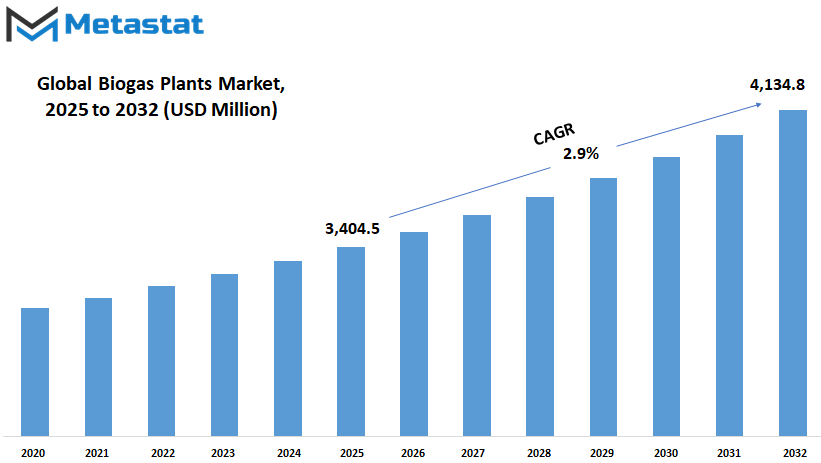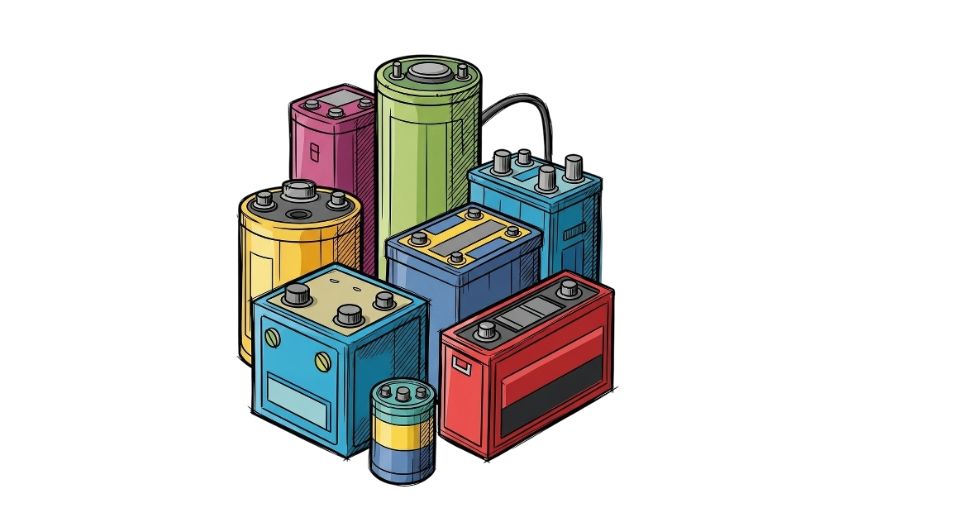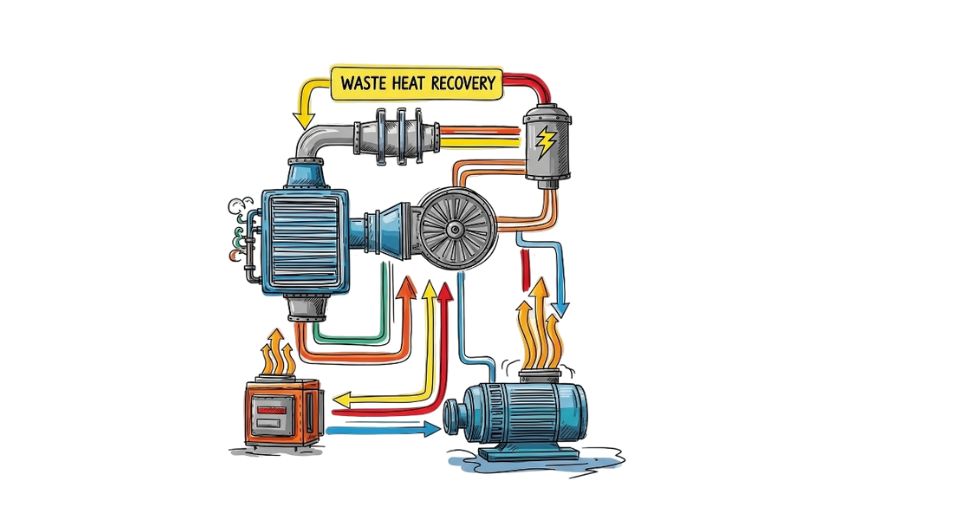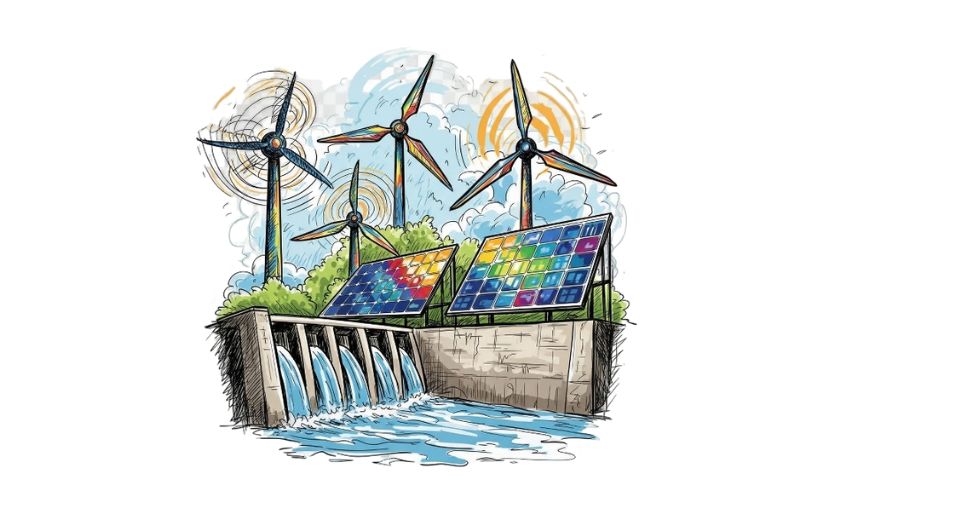MARKET OVERVIEW
The Global Biogas Plants Market is an important part in the renewable energy sector that works toward developing, installing, and operating plants to turn organic waste into biogas. These plants are expected to assume a significant role in addressing fossil fuel dependency through sustainable methods of power generation and waste management. Also, biogas plants would perpetually have a renewable energy resource by making energy from agricultural residuals, municipal wastes, and industrial byproducts used in conserving the environment and energy security.
Technological advancements in anaerobic digestion and gas upgrading systems will probably define the Global Biogas Plants Market. Facilities will be designed for maximizing methane yield and efficiency and for upgrading the quality of biogas for specific applications. The ability to clean raw biogas up to biomethane-grade standards would favorably position its injection into natural gas grids as a cleaner substitute for other fuels. Further development in biogas plants will be probably enabled by other innovations relating to feedstock utilization, which allow for efficient processing of a much wider range of organic feedstock.
Challenges arising out of waste management will contribute to the market expansion for Global Biogas Plants. Existence of biogas plants will be attractive to governments and industries committing to sustainable waste-disposal practices and efforts of a circular economy. By converting biodegradable waste to energy, these plants would reduce landfill dependency and mitigate greenhouse gas emissions. Integration of biogas plants by municipalities, agricultural businesses, and food-processing companies will move with increased synergy across a global sustainability agenda.
Agriculture will always be a stronghold in the Global Biogas Plants Market since farms produce large quantities of organic waste capable of being converted to biogas. Valuable feedstocks will include livestock manure, crop residues, and food processing waste. An on-site biogas plant would empower farmers to acquire their own energy without negatively impacting the environment. The viability of using digestate, a byproduct of biogas production, as a highly nutrient-rich fertilizer will further increase the profitability of biogas facilities in agriculture.
Infrastructure development will gain traction in the Global Biogas Plants Market. Enhancement of gas distribution networks, storage solutions, and refueling stations for biogas-powered vehicles will encourage adoption of biogas technology. Investments in decentralized energy structures will serve to motivate the erection of small- and medium-sized biogas plants in the backdrop of endemic energy solutions for rural and off-grid areas. The market will be evolving to accommodate the varied energy requirements in the backdrop of increasing renewable energy sources.
Global Biogas Plants market is estimated to reach $4,134.8 Million by 2032; growing at a CAGR of 2.9% from 2025 to 2032.

GROWTH FACTORS
The Global Biogas Plants market is on the verge of soaring. Environmental concerns and depletion of fossil fuels are urging industries and government sectors to look for cleaner alternatives. The possibility of transforming organic waste to energy through biogas plants reduces the dependence on non-renewable sources as well as offers solutions to waste disposal problems. The dual advantages this offers are what make biogas so favorable in energy generation as well as environmental protection.
Biogas plants are being driven to more and more into the renewable market by recognition for same. Governments around the world are creating aggressive targets for cutting carbon emissions; biogas is intrinsic to that effort. Increase opening windows for incentive, subsidy, and policy considerations for industry to invest in biogas plants through the regulations. Thus, while biogas and these renewable sources still have not gained wide customer acceptance, many have come on board with programs to support commercial viability for penetration into the renewable energy matrix.
Yet, amid these opportunities, the markets have winds blowing against their growth. Some of the key impediments for any would-be market entrants are high investment cost and lack of a proper infrastructure. The financial implications of the biogas plant establishment act as a huge burden, and further costs on the operational maintenance make the promoters reluctant to go ahead. Also, sourcing organic wastes, in the open, can pose problems. Availability of feedstock may vary from one region to another, i.e., agricultural wastes, food remnants, and animal dung. Moving this feedstock to biogas plants presents logistical hurdles that require suitable solutions.
There is plenty more to come with advancements in technology and new applications of biogas. Along with power generation, gas is now considered to be upgraded into biomethane for usage as fuel in vehicles and for industrial applications. These new considerations allow further opportunities to incorporate earnings while help reduce traditional fuel dependency. Better exposure to biomethane advantages is expected to create demand, which will consequently mean more innovation in the sector.
How the obstacles are countered, and their acceptance rate will endorse a bright future for the Global Bio-Gas Plants market. The continued support from the governments, technological developments, and increasing knowledge about the benefits of renewable energy will consolidate biogas ever more firmly into the energy sector on a global level. Companies that invest in innovative solutions and in extending the application avenues of biogas simply must be watched in this booming market.
MARKET SEGMENTATION
By Type
With the sharp focus on sustainable energy solutions, the Global Biogas Plants market is likely to be driven forward. Biogas is increasingly becoming a frontrunner as the renewable energy that fights waste, with industries and governments searching for alternatives to conventional energy. The technological progress that will support cost-efficient and easy applications of biogas production will continue to expand the market. Stricter environmental regulations set worldwide will encourage industries to invest in biogas plants for emissions reduction and the proper management of organic waste.
The market will get defined by the types of biogas plants. Fixed-dome will continue to be favored among durable and cost-effective types for most of its applications in rural and agricultural settings. These plants provide long-term solutions that require minimal maintenance, thus making them highly preferred by communities and small-scale operations. Balloon plants, on the other hand, provide flexible structures and relatively easy establishment and transportation. This kind of plant will get prominence in regions where temporary or mobile energy solutions are needed. Floating-drum plants will continue to be preferred for the industries demanding steady supply and pressure control for energy generation.
Innovations would push companies to maximize the efficiency of biogas plants. Use of advanced materials and automation would increase performance, speediness, and reliability of the whole operational procedure. Smart monitoring systems would enable real-time monitoring of gas production and usage to optimize output and minimize wastage. AI in biogas plants will enhance predictive maintenance, preventing breakdowns and optimizing operational efficiency. These advancements will certainly make biogas a more cost-efficient option for industries seeking to reduce costs and transit toward cleaner forms of energy.
The Global Biogas Plants market will also benefit greatly from increased investment in research and development. Governments and private entities will work together to develop improved designs for the plants and promote the technology within urban settings. On a larger scale, plants will be set up to respond to renewable energy demand, while smaller decentralized systems will provide off-grid energy solutions to remote areas. Progress in biogas purification will lead to the further viability of the injection of biogas into the pre-existing energy grids, laying the foundation of future energy systems.
As sustainable solutions become prominent, biogas plants will take an important slot in global energy production. Companies in partnership with policymakers will fast-track biogas technology uptake across several regions. Such improvements will determine the market future, ensuring biogas remains a practicable, steady, and sustainable energy source for many generations to come.
By Feedstock Type
The increasing demand for clean energy will mean that the market for Global Biogas Plants continues to grow. Biogas is gradually turning out to be a practical solution for renewable energy generation in light of significant concerns regarding environmental sustainability and reducing dependency on fossil fuels. Therefore, governments and various industries make investments in biogas plants for waste management and energy production applications for electricity, heating, and transportation. Improvement in the technology will earn the production of biogas larger efficiency in Time to come, thus making it a more attractive option of energy generation.
One of the most critical parameters determining the future of this industry is the type of feedstock used in biogas plants. The main raw materials used in biogas production include agricultural waste, animal waste, sewage sludge, and industrial waste. It can convert organic waste into usable energy, which makes biogas plants one of the most critical strategies for sustainable development. The importance of agricultural waste such as crop residues and discarded produce in providing a continuous supply of organic matter for biogas plants will be substantial. Farmers will profit from this in the end, providing a better option for managing waste and making it into an additional source of income.
Animal waste again provides a heavy share of such types of energy production. Livestock farms produce large amounts of organic waste, which, when subjected to biogas technology, can easily be converted into energy. This also helps prevent methane emissions and provides alternative energy sources for farmers. The sewage sludge that is generally produced in wastewater treatment facilities will also soon be efficiently utilized for biogas production. This is something that many cities and municipalities are clearly recognizing regarding the potential of using sewage sludge for generating energy, as part of solutions to waste management.
Industrial waste continues to be one of the major sources for producing biogas as most industries tend to reduce their environmental footprint doing so. Different manufacturing units produce organic waste capable of conversion into biogas in order to utilize produced energy better and reduce overall costs for disposal of waste. Aside from these main feedstocks, many other organic materials like food waste will also form a chunk of the biogas sector's growth.
The outlook for the Global Biogas Plants market is bright as new technologies would further enhance energy output and efficiency. By installing advanced automation and more control systems, energy conversion maximizes during biogas production going forward. The ongoing R & D activities will put the industry in a better position in storage, transportation, and distribution of biogas to turn it into a reliable alternate source of fuel. Biogas plants, with increasing pro-activity from more industries and governments, hold a significant space in building a cleaner and more sustainable future.
By Application
The Global Biogas Plants market will see further growth with the rising importance of renewable energy. Biogas plants will be involved in future energy demand for the reason that industries and governments are seeking clean alternatives to conventional energy sources. Sustainability has encouraged investments to enter into biogas production, in which technology is being further developed to enhance its efficiency. As more corporations and communities drive the recognition of the benefits of biogas, its application will enter into the wider industrial and agricultural sectors.
Industries now are actively looking for ways to minimize carbon footprints and improve energy efficiency. Biogas plants present the opportunity through energy conversion from organic waste, thus significantly sustaining less usage of fossil fuels. Thus, biogas production will become integrated within many companies' operation to lessen their cost and achieve the environmental objectives. Such an opportunity would breed innovative concepts in plant design which will be made flexible concerning different industrial needs. Exploration will also take place for ways to enhance energy output and improve waste management systems in order to ensure biogas stays as a sustainable energy source.
Agriculture is expected to remain one of the leading sectors benefiting from biogas plants. Farmers want an effective way of disposing of organic waste while generating extra income through energy generation. Biogas plants enable them to convert agricultural by-products into exotic resources, thus minimizing degradation on the environment while maximizing farm efficiency. In anticipation of greater demand for renewable energy, more farms will migrate toward this biogas technology with the backing of government incentives and policies promoting sustainability.
The market trends for future Global Biogas Plants are bound to be dictated by the technological advents that follow suit for energy production and efficiency. Automation and digitalized supervision are designed to render biogas plants on par with the demand by fast-tracking reliable energy output and maximizing low maintenance costs. Firms in this segment will focus on simplifying operation in biogass installations in order to sustain mass deployment. Increased research will also bring about breakthroughs on how various organic wastes are being handled, thereby broadening the scope of materials admissible for energy generation.
The biogas industry should see the ongoing development as awareness deepens on climate change and alternative energy options. Industrial and agricultural applications feeding demand will see biogas becoming an integral component of the global energy mix. Companies and governments will join hands toward the expansion of biogas infrastructures, paving the way for a cleaner and sustainable tomorrow.
By End Users
With the world shifting toward cleaner energy solutions, the Global Biogas Plants market will continue to see growth. Renewable energy sources have drawn the attention of industries with concerns over environmental sustainability, leading to the reduced dependence on fossil fuels. Biogas plants are a viable means of converting organic waste into energy in support of carbon emission abatement. This makes them all the more necessary, as the governments begin to promote green energy.
Investment and support for biogas technology by companies and investors will bring further research and development to improve efficiency and cost of biogas processes. As technologies continue to evolve, it is expected that the biogas plants will see advancements in energy yield while reducing operational wastage. On the way to a circular economy, anaerobic digestion and gas purification innovations will help industries utilize organic materials more efficiently, providing a lesser degree of landfill waste. These advancements will speed up acceptance in different domains, creating more business opportunities for integrating biogas into energy strategies. Focusing on efficiency and automation will permit companies to optimize energy production and minimize operating costs.
The Global Biogas Plants market will experience increasing demand from various industries. Power and energy will remain a sector that contributes heavily as biogas provides an alternative to conventional electricity sources. Several power generation corporates will be investing in large-scale facilities to support national grids and provide renewable energy to businesses and households. The oil and gas sector can also gain from this development as biogas could be converted into biomethane, regarded as a greener alternative to conventional natural gas. This transition will help companies meet their sustainability objectives while reducing the reliance on non-renewable resources.
This is the area where automotive will also contribute to demand growth. With increasing emphasis on reducing emissions from vehicles, biogas fuels are expected to become alternate fuels for gasoline and diesel. Transport businesses will look into the means to integrate biogas into refueling stations so that businesses and consumers are enabled to make the transition to cleaner sourcing easily. Other industries supporting market growth would include agriculture and waste management, which will see further development as farms and food processors adopt biogas systems to manage waste more efficiently while converting energy into a second revenue line.
With technology furthering, the outlook for the Global Biogas Plants market looks good. This will spur R&D investment leading to enhanced performance and broader applicability as other industries are convinced of the benefits of biogas. This will have biogas solidly in the center of the international ventures toward cleaner and more sustainable energy solutions.
|
Forecast Period |
2025-2032 |
|
Market Size in 2025 |
$3,404.5 million |
|
Market Size by 2032 |
$4,134.8 Million |
|
Growth Rate from 2025 to 2032 |
2.9% |
|
Base Year |
2024 |
|
Regions Covered |
North America, Europe, Asia-Pacific, South America, Middle East & Africa |
REGIONAL ANALYSIS
The need of the hours is for the continuation of providing sustainable energy solutions that further encompasses biogas plants in paving the ways for this cleaner movement. With industries and their governments doing more for cleaner energy, more and newer markets will be opened in the Global Biogas Plants arena. Every region contributes in its own way in terms of energy policy, raw material availability, and technological advancement to this movement. Countries develop investments in biogas infrastructure to tackle environmental issues, give proper waste management, and renewable energy generation in different types of applications.
North America is going to probably remain one of the most promising regions, with countries like the U.S., Canada, and Mexico all moving forward to boost biogas production. Government initiatives that support biogas projects have been on the rise in the U.S., while Canada has emphasized the conversion of agricultural wastes into clean energy. Mexico is trying to identify further opportunities to develop its biogas market, focusing mainly on waste management and rural electrification. The combined efforts would yield a steady increase in biogas output in this region.
Europe has been at the forefront of renewable energy production, and biogas plants will serve as a mainstay of its strategy to realize the renewability targets. It is in the UK, Germany, France, and Italy that advanced investments in biogas technology will be carried. Of all these, Germany is known to be a forerunner in biogas came, where the emphasis is on upgrading to high producing biomethane facilities. Looking to increase investments in biogas initiatives to support cleaner energy initiatives are France and Italy, as more European nations adopt similar policies to encourage biogas. The whole sector will continue to expand in the future.
First, Asia-Pacific has a bright future in terms of growth because of rising energy demands and a vigorous focus on mitigation of environmental impact. The area is primarily pursuing biogas production on a large scale in countries such as India, China, Japan, and the Republic of Korea. India exploits agricultural and organic wastes to improve the biogas yield, but for China, biogas is part of its carbon reduction approach. Biogas has also been integrated into renewable energy portfolios of Japan and South Korea, with technology being the driving force for efficiency improvement. Strong growth is expected in this region as governments continue to provide greater support in biogas projects.
South America is gradually increasing its production of biogas, with Brazil and Argentina showing more potential interest. Brazil is developing biogas plants very much from agriculture and livestock activities, while Argentina is laying an effort to adopt new projects regarding organic waste use. Meanwhile, the whole of the Middle East & Africa has started exploring biogas potential as a sustainable source of energy. Countries within the GCC, Egypt, and South Africa are now beginning to invest in building up biogas infrastructures for the sake of diversifying energy sources and waste management improvements.

COMPETITIVE PLAYERS
The Global Biogas Plants market will see great advancement in the near future, with industries and governments now focused on sustainable energy solutions. There is a growing need to eliminate fossil fuel reliance, thus attracting increasing attention for biogas production as an environmentally friendly alternative. Increasing renewable energy utilization is expected to further bring investment in biogas plants that promote innovations and enhancement in production methods. The companies are alleged to be in the process of finding ways to optimize the operation of their plants, enhance energy generation, and improve waste management, thereby cementing biogas as a sustainable energy source for both industries and homes.
Big technological enhancements will reign supreme in the future of biogas plants. The Companies work toward the refinement of anaerobic digestion processes to maximize gas production from organic waste. Advanced monitoring systems will ensure that operational stability is maintained while allowing plant operators to maximize efficiency and detect problems in real-time. Automation and AI-driven solutions will become the norm, ensuring that there is less manual intervention, consequently enhancing the overall plant performance. These changes will render biogas production friendly and affordable, thereby encouraging uptake across sectors.
The Global Biogas Plants market will see stiff competition from key players striving to enlarge their presence. Companies in the business, such as Agraferm GmbH, Air Liquide, and Ameresco Inc., have all in mind the technological advancements that provide improvement in energy conversion rates. On the other side, firms such as BioConstruct, BTS Biogas, and EnviTec Biogas AG are also increasing their infrastructure to meet the demands posed by renewable energy. Companies such as Finn Biogas, Hitachi Zosen Inova, and HoSt are busy researching advanced technologies for developing a more efficient waste-to-energy. With an increased focus on the environment, companies including IES BIOGAS, KIEFER TEK LTD, and Ludan Group study the development of sustainable materials and methods for enhancing biogas production.
Competition amongst key players will prod the emergence of other strategies until they prove biogas to be economically and practically viable. Lundsby Biogas A/S, Mitsui E&S Engineering Co., Ltd, and Naskeo are engaged in the establishment of projects interfacing biogas with existent energy grids aimed at securing a stable supply of renewable power. On the other hand, Nature Energy, PlanET Biogas Global GmbH, and SEBIGAS will focus on waste management that promotes sustainable biogas production. Companies WELTEC BIOPOWER GmbH and Zorg Biogas AG are also key players in the growth of the industry with new plant designs and expansions in the production capacity.
As technology continues to evolve, the importance of biogas in the world energy mix will grow as more industries seek cleaner energy sources. The expansion of biogas plants and continuous processing innovation will guarantee that this renewable energy source continues to play a significant part in the transition towards a sustainable future.
Biogas Plants Market Key Segments:
By Type
- Fixed-Dome Plants
- Balloon Plants
- Floating-Drum Plants
By Feedstock Type
- Agricultural Waste
- Animal Waste
- Sewage Sludge
- Industrial Waste
- Others
By Application
- Industrial
- Agricultural
By End Users
- Energy and Power
- Oil and Gas
- Automotive
- Others
Key Global Biogas Plants Industry Players
- Agraferm GmbH
- Air Liquide
- Ameresco Inc.
- BioConstruct
- BTS Biogas
- EnviTec Biogas AG
- Finn Biogas
- Hitachi Zosen Inova
- HoSt
- IES BIOGAS
- kIEFER TEK LTD
- Ludan Group
- Lundsby Biogas A / S
- Mitsui E&S Engineering Co., Ltd
- Naskeo
- Nature Energy
- PlanET Biogas Global GmbH
- SEBIGAS
- WELTEC BIOPOWER GmbH
- Zorg Biogas AG
WHAT REPORT PROVIDES
- Full in-depth analysis of the parent Industry
- Important changes in market and its dynamics
- Segmentation details of the market
- Former, on-going, and projected market analysis in terms of volume and value
- Assessment of niche industry developments
- Market share analysis
- Key strategies of major players
- Emerging segments and regional growth potential








 US: +1 3023308252
US: +1 3023308252






